September 5th, 2023
An intricately carved nasal ornament made from human bone was recently unearthed during the exploration of the ruins of Palenque, an ancient city in the southeastern Mexican state of Chiapas. Dating back at least 1,100 years, the nasal attire was likely worn by rulers and priests as an embodiment of K'awiil, the Mayan god of corn and fertility.

Carved from the human distal tibia (the bone of the lower leg that connects with the ankle), the jewelry has an engraved scene that expresses communication with the gods and ancestors. When affixed to the nose, the ornament would have given the user the appearance of having a continuous line from the forehead to the tip of the nose — similar to the shape of an ear of corn. The piece was likely worn during religious ceremonies.

The distal tibia provided the perfect shape for the nose ornament because of the crest that runs along the bone. The jewelry measures 6.4cm (2.5 in) long by 5.2cm (2.0 in) wide, and is thicker at the bottom than it is towards the top.
This is the first nasal ornament to be unearthed in Palenque, although this type of jewelry has appeared in several sculptural representations, such as the lid of the sarcophagus of the famed 7th-century Mayan king Kʼinich Janaab Pakal.

The intricate carving has a distinct left and right side. One half of the piece shows the profile of a Mayan man wearing a headdress depicting the head of a bird, tubular wristbands and a necklace of spherical beads. On his left arm is the Mayan glyph ak'ab' meaning “darkness” or “night.”
His right arm extends to the other side of the piece, where it holds a long and thin object. In the lower part of that side is a representation of a human skull without a lower jaw. The skull is placed on what appears to be a bundle of cloth marked with cross bands.

Arnoldo González Cruz, director of the Palenque Archaeological Project (PAP), explained that the extraordinary piece was part of a ritual deposit interred during the Late Classic period (600 and 850 AD) to commemorate the completion of a building that was part of a large architectural complex.
Cruz and his team discovered the nose jewelry among other artifacts, which included obsidian blades and fragments of a bone awl. Conservation work at the Palace of Palenque is being conducted by Mexico's Federal Ministry of Culture, through the National Institute of Anthropology and History (INAH).
Credits: Photos and illustrations by Carlos Varela Scherrer, courtesy of the National Institute of Anthropology and History (INAH).

Carved from the human distal tibia (the bone of the lower leg that connects with the ankle), the jewelry has an engraved scene that expresses communication with the gods and ancestors. When affixed to the nose, the ornament would have given the user the appearance of having a continuous line from the forehead to the tip of the nose — similar to the shape of an ear of corn. The piece was likely worn during religious ceremonies.

The distal tibia provided the perfect shape for the nose ornament because of the crest that runs along the bone. The jewelry measures 6.4cm (2.5 in) long by 5.2cm (2.0 in) wide, and is thicker at the bottom than it is towards the top.
This is the first nasal ornament to be unearthed in Palenque, although this type of jewelry has appeared in several sculptural representations, such as the lid of the sarcophagus of the famed 7th-century Mayan king Kʼinich Janaab Pakal.

The intricate carving has a distinct left and right side. One half of the piece shows the profile of a Mayan man wearing a headdress depicting the head of a bird, tubular wristbands and a necklace of spherical beads. On his left arm is the Mayan glyph ak'ab' meaning “darkness” or “night.”
His right arm extends to the other side of the piece, where it holds a long and thin object. In the lower part of that side is a representation of a human skull without a lower jaw. The skull is placed on what appears to be a bundle of cloth marked with cross bands.

Arnoldo González Cruz, director of the Palenque Archaeological Project (PAP), explained that the extraordinary piece was part of a ritual deposit interred during the Late Classic period (600 and 850 AD) to commemorate the completion of a building that was part of a large architectural complex.
Cruz and his team discovered the nose jewelry among other artifacts, which included obsidian blades and fragments of a bone awl. Conservation work at the Palace of Palenque is being conducted by Mexico's Federal Ministry of Culture, through the National Institute of Anthropology and History (INAH).
Credits: Photos and illustrations by Carlos Varela Scherrer, courtesy of the National Institute of Anthropology and History (INAH).


